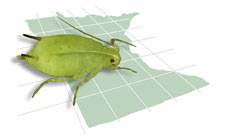 |
Keep an eye out on your soybeans for soy bean aphid as
they have been found in MI See following message from Dr. Chris DeFonzo.
Here is a photo of one

-----Original Message-----
From: Field Crops AOE [mailto:[log in to unmask]] On Behalf Of Chris
DiFonzo
Sent: Friday, June 01, 2007 7:57 AM
To: [log in to unmask]
Subject: SBA found in Michigan
Soybean aphids were found on soybean in Michigan
yesterday in Berrien
County (Mike Staton wins the box of freezie-pops), on
the MSU campus,
and at the Bean/ Beet Farm in Saginaw. Infestation
is less than 1%
at each location. Ants on plants really help to key in
on colonies.
Here is an excerpt
from Kathleen Delate’s research from Iowa State Univ of an overview of
the insect pest.
The soybean aphid (Aphis glycines Matsumura)
is native to China and
Japan, and was a new pest
in Iowa in 2000. Aphid
numbers were high in
the 2001, but in 2002 and
2003, aphids appeared
to be less of a problem.
This small, yellow aphid
has distinct black
cornicles (“tailpipes”) on the
tip of the abdomen and
develops colonies on
soybean plants as winged
and wingless forms.
Aphids feed through
piercing-sucking
mouthparts. The winged
form has a shiny black
head and thorax with a
dark green abdomen and
black cornicles. The
soybean aphid is the only
aphid in North America
that will reproduce on
soybeans. Therefore, any
small colony of aphids
found on soybeans must be
soybean aphids. The
aphid may have up to 18
generations a year,
beginning with
overwintering eggs on the
alternate host of
buckthorn trees. These eggs
hatch into nymphs and two
generations of
wingless females develop
on buckthorn, before
the winged generation
flies to soybean fields in
the spring. Winged
generations appear on
soybean plants in the
case of crowding from
wingless colonies, and in
the fall, a winged
generation migrates back
to buckthorn. These
females produce a
wingless generation that
mates with winged males
and lay eggs on the
buckthorn trees. Soybean
aphid populations
build and peak during the
period between late
seedling stage to
blooming stage. Usually in late
July, the aphids move
from the terminal area of
the plant to the
undersides, making control more
difficult. Honeydew and
sooty mold (the
excrement of the aphid
and the resulting black
fungus that grows on it)
are apparent in August
and September. Stunted
plants, reduced pods
and seeds may result from
aphid feeding. Also,
soybean aphids can
transmit viruses that cause
mottling and distortion
of the leaves and a
reduced seed set.
Discolored seeds may also
result from this
infection.
An economic threshold of
250 aphids per plant
if the population is
increasing and plants are in
the late vegetative or
early (R1-R4)
reproduction stages has
been established (ISU,
2004). This incorporates
a seven-day lead-time
before the aphid
population would be expected
to increase to 1,000
aphids per plant, which is
the economic injury level
and the population
size that would be
expected to cause economic
damage (i.e., yield loss
that exceeds the cost of
control). There are
several natural enemies that
help manage the aphid,
including lacewings,
Asian lady beetles, and
entomopathogens (fungi
that infect insects,
causing a reddish-brown
appearance and death).
The Leopold Center offers some good
biological approaches that can compliment your treatments. Keep in mind when
spraying any pesticide (even if organic) it may impact beneficial insects as
well as the targeted pest.
<><><><><><><><><><><><><><><><><>
Dr. Christina DiFonzo
Field Crops Entomology Program
Michigan State University
East Lansing, MI 48824
Mailing Address: 243 Natural Science Building
Office Address: 331 Natural Science Building
tel: 517-353-5328 fax:
517-353-4354
<><><><><><><><><><><><><><><><><>